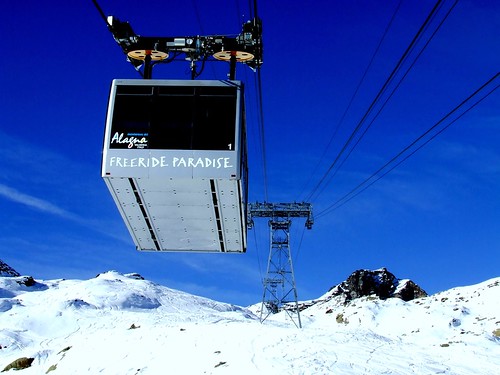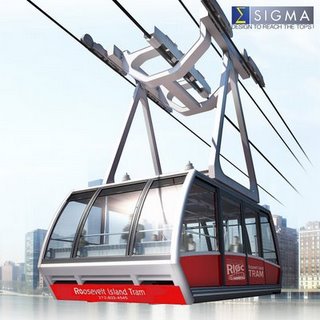The last aerial cable technology worth mentioning is the Funifor. Like the 3S, Funifors are very rare beasts. Only around a half dozen exist, and are all located in northern Italy (for whatever strange reason).
In essence, the Funifor is nothing more than a fusion of a Funitel and an Aerial Tram. It’s dual grip mechanism allows for a short grip arm and a more stocky, yet purposeful appearance. It doesn’t appear to dangle like other aerial systems. Like an Aerial Tram, however, it lacks the Funitel’s detachability. This means longer than normal wait times and lower capacity. It also means intermediary stations are very difficult and the technology is best used for point-to-point applications.
Like most Aerial Trams, a Funifor runs on a parallel set of support ropes, though the pair are spaced wider apart than standard Aerial Trams.
What distinguishes a Funifor from an Aerial Tram is that each of the two cabins operate separately. As opposed to an Aerial Tram, a Funifor’s propulsion rope is not returned to the opposite direction for use by the other vehicle. Instead, each cabin uses its own set of bullwheels, engines and propulsion ropes. (That’s why when you see pictures of a Funifor, each direction appears to use 4 separate ropes; two for support, one for propulsion plus the return part of the propulsion loop.) This allows a Funifor three distinct advantages over an Aerial Tram:
- As cabins operate independently of each other, higher capacity can be realized through reduced wait times.
- Intermediary stations become possible in locations other than the exact mid-point.
- In the event that one line shuts down due to emergency and or maintenance, the other line can still operate. Yes, that means that capacity is reduced by half, but at least the system is still in operation.
- If evacuation of a vehicle is necessary, the second vehicle can be used. Funifors can be equipped with bridging equipment allowing passengers to move from the disabled vehicle over to the other operational line.
These advantages, however, are offset by a couple of negatives:
- Towers are necessarily larger and sturdier in order to carry the extra load.
- Doubling of engines and propulsion ropes causes a significant increase in cost.
If one were choosing between an Aerial Tram and a Funifor in an urban environment, it would be best to opt for the Funifor. The added capacity, reduced travel times, maintenance potential and evac procedures makes it an obviously superior choice. Yes, it’s more expensive, but on balance worth it.
Why, after all, do you think New York opted to rebuild the Roosevelt Island Tram as a Funifor? Given that the terminals were already built, the $25 million USD price tag that came with this rebuild made the choice easy.
(In fairness to the manufacturer Sigma (one division of the Poma-Leitner group), this is not strictly-speaking a Funifor. Funifor – the word – is a trademarked name of the Doppelmayr Garaventa Group. Sigma’s design, however, clearly captures all that a Funifor is.)



13 Comments
Hi, thanks for all the info, its nice to see a good user-friendly english site with all this info. I finally ended up learning french to learn all this stuff, so it is greatly appreciated, i will share it!
Id like to add that i think theres a mistake in the 4th paragraph:
What distinguishes a Funifor from an Aerial Tram is that each of the two cabins operate separately. In an Aerial Tram, the propulsion rope is not returned to the opposite direction for use by the other vehicle.
where it says In an Aerial Tram, it should say In a Funifor.
again thanks and keep it up.
PS even though its not useful as a CPT, you should still put some info about teleskis, detachable and fixed.
Diego,
Thanks so much for spotting that, correction made! And thanks so much for the support and kind words.
I also recently realized another advantage of Funifors over Aerial Trams: The ability to include intermediary stations. I’ve edited the post and included it in the list of advantages.
Teleskis . . . now there’s something all together different :).
“The ability to include intermediary stations.”
Later on? Theoretically? I’d like to have a little bit more information.
LX,
Either can have intermediate stations, neither is that likely to have them.
Because aerial trams are permanently attached to the cable, any time one car stops all cars must stop. So you don’t want cars making random stops at places that aren’t stations, so you’re limited to no more cars than there are stations, and the stations have to be perfectly regularly spaced, and that is difficult to make work so generally you just have two stations.
Because the two cars in the funifor move independently, you could add an intermediate station anywhere along the line. However, you can only have two cars on the whole line, so you wouldn’t build a long line with a lot of stations with this technology anyway. There’s also the issue that someone in the intermediate station might have to stand at either platform as the lines on both sides run both directions, and this may cause confusion.
There’s no reason an aerial tram with two lines couldn’t use two separate propulsion ropes, nor is there any reason an aerial tram couldn’t be built as a single line, I think the reason why two trams on one rope is so common is that they are typically used on hill climbing routes so two trams on one rope allows them each to serve as a counterweight for the other.
The Doppelmayr Funifor has a different drive arrangement than the Sigma design. Look at the diagram of the funifor drive cable layout on this page: http://win.funivie.org/pagine/speciali/200x/fuf_zoncolan/scheda.htm This design feature helps with the wind stability.
The biggest advantage of the Funifor design is its wind stability owing to 2 track cables spaced widely apart and the fact that its short car hangers allow the cable to be run closer to the ground (e.g. when going over a peak).
@ Terry,
“Doppelmayr Funifor has a different drive arrangement than the Sigma design.” Totally agree. I normally use the phrase “Funifor-syle” or “Funifor-like” to describe the Roosevelt Island Tram because I’ve yet to learn the actual technical term for Sigma/Poma/Leitner’s system. And while the drive arrangement may be different, the effects are from a ridership perspective the same – two trams operating independently of one another with greater wind stability.
Unfortunately, nomenclature sometimes gets in the way. Because both companies have their own technologies/patents/designs arguments about the proper term can often creep up. It’s like the whole Funitel vs. Double Loop Monocable issue.
Hi Steven,
Great website. In reading about Funifor, I was reminded about the Areobus technology at, http://faculty.washington.edu/jbs/itrans/aerobus.htm
Not sure if this “counts” as a cable propelled technology, but it does run on cables.
Cheers.
Hi Peter,
Thanks for the kind words and sorry for the delayed response. I’m well aware of the “aerobus” and find it quite bemusing. I honestly know very little about systems such as these.
One of the advantages of cable propelled systems is that all vehicles are moved by the same engine. That reduces maintenance and increases reliability because there’s one system to maintain, not dozens. That does present some problems in the event of a failure, but those are rare.
Nevertheless, I think the reason the Aerobus never caught on is because it’s simply absurd to look at. It’s very hard to take it seriously.
Please remove references to Roosevelt Island aerial tramway (NY) as a Funifor.
Funifor is a patended design of Doppelmayr-Garaventa, as NY cable car has been rebuilt by Pomagroup.
In fact, the NY tram concists in two independent systems of “wide gauge” cable car, each track having only one vehicle. This provide independent operation of each vehicle, and accurate wind stability for the lift.
The Funifor design is based on a dual-loop hauling rope, with four pulleys on each vehicle to send the rope back to stations. The main topic is to be able to run the rope during nights without moving vehicles, for anti-icing purpose.
(see diagram on http://www.remontees-mecaniques.net/fonctionnement_rm/tph_2.php – in french..)
eventough as first look the wide gauges of both systems seems to be similar, it isn’t !!
First off, my apologies. As you’ll notice this post is a year old. We’re currently updating several of our lessons to address issues like the one’s you’ve described. If you note at the bottom of the page, we do say clearly that the Roosevelt Island Tram is not a Funifor.
I will ensure that this module is adjusted to deal with these issues next week.
Our purpose with The Gondola Project is to make cable transit technology more accessible to the general reader and transit planning professional. As such, we focus more of our attention on the performance characteristics of the technologies rather than the exact means by which it’s accomplished.
So while the RIT may not be a Funifor, it does have identical performance characteristics as a Funifor – two Aerial-Tram like vehicles with excellent wind stability moving independently of one another. From a transit planning perspective, that’s all that really matters. That’s why we always say that the RIT is a “Funifor-style” installation.
Could you tell me what name Poma prefers to use for their version of the Funifor? Or is it simply a Dual Haul/Parallel Aerial Tram?